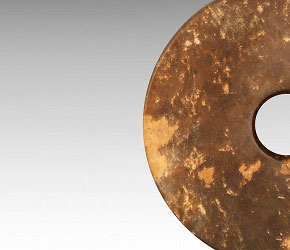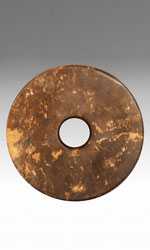| |
 |
| |
Chinese hard stone bi (detail) |
Since
Neolithic
times, the
Chinese
have been master carvers of jade and other
hardstone
ritual and decorative objects. Various forms of hard stone artifacts have been dated to as early as 5000 BC. The actual meaning of these objects is not clearly known, but they were likely intended to serve as status symbols. Consequently, enormous labor was involved in perfecting their abstract shapes and lustrous finishes. Their more recent production represents the continuity of Chinese culture through repetition and imitation of revered classical forms.
Round discs
with concentric central holes were called
“bi”
(pronounced bee) and were perfected by the
Liangzhu
culture. Recent scholarship suggests that these round forms were meant to evoke the “dome of the heavens” or the path of the sun itself. The distinctive bi discs of the earlier
Hongshan
culture were rectangular with rounded corners, and many had two much smaller holes at the top for suspension. The bi form was the highest emblem of noble status because of its perfect shape. These were also called
Cong.
 |
|
| Chinese hard stone bi |
|
Today, these perfect objects convey both prestige and a strikingly organic purity of design. To many people, they represent the “circle of life,” a continuous form with no beginning, middle or end, but a distinct center containing the unknowable truths. In turn, Congs are appreciated for their distinct contemporary form, which is both anthropomorphic and abstract at the same time.
Download this Article: Archaic Chinese Hard Stone Bi.pdf

